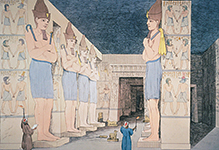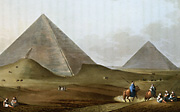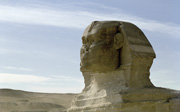
Egypt
Birth and Death,Cult and Gods,Pharaos and Officials,Pyramids and Temples,Daily Life.

#08011043
Various amulets for the living and the dead. From top left to bottom right: Dj...

#08011044
Ushebtis, tomb-servants, from various periods. From left to right: pain...

#08011045
The dead Pharaoh Seti I (1301-1290) before Osiris. Pillar from the tomb cha...

#08011046
Pharaoh Amenophis I (1533-1512) and Queen Ahames-Nefertari as patr...

#08011047
The eighth hour of the Anduat (Book of the Underworld). The ship of Ra floats th...

#08011048
From the book "Guide through the Underworld": Left to right: The Theban Weste...

#08011049
From the book "A Guide through the Underworld" (sequel to 08-01-10/48). From le...

#08011050
So-called "intercourse-figures" to maintain and increase male and female...

#08011051
Pectoral of the Chief Ointment-maker Pa-nehersj. Two goddesses, Isis and Neph...

#08011052
Offering scene with table of offerings, from the tomb of Ria. Second woman fro...

#08011053
Heartshaped scarab; the inscription on the reverse side of another scarab asks t...

#08011054
Canopic shrine (receptacle for intestines after mummification) in the fo...

